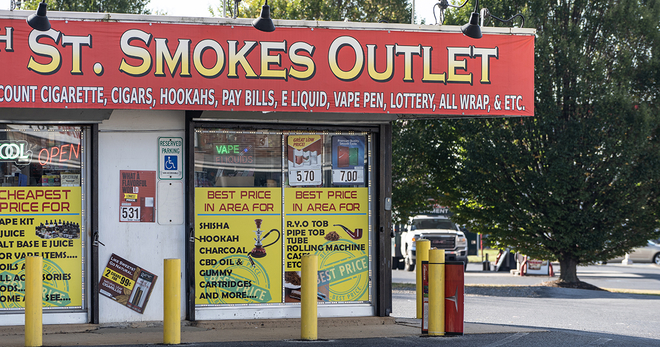How companies control where you see tobacco products and what policy can do about it
Tobacco companies spent over $8.47 billion on marketing in retail establishments, also called point-of-sale marketing, in 2015 (the most recent figures available). This article is part of a series highlighting ways that states and localities are countering the deep pockets of the tobacco industry with policies regulating where and how tobacco products are sold.
There’s a reason why 93 percent of tobacco displays and 85 percent of tobacco shelving units are in the counter zone of retail establishments — in most stores, the cashier counter is the best place to encourage impulse purchases.
Tobacco companies pay retailers to place their products and other items, such as branded signs, displays and shelving units, in highly visible locations around checkout counters, and in other easy-to-see spaces in retail environments. The tobacco industry spent almost $646 million of its over $8.9 billion marketing budget on these types of financial incentives to wholesalers and retailers in 2015, a sum that also includes money for volume discounts and free products retailers can later sell to consumers.
Where stores place tobacco products and ads can influence whether people smoke, but good policy at the state, local and federal level can limit the impact.
Why placement matters
The placement of tobacco products and ads can affect smoking behaviors in several ways.
For example, one study used a virtual convenience store to create two scenarios: one with a tobacco product display fully visible and another with the display enclosed behind a cabinet. Recent quitters and current smokers who experienced the enclosed display had lower urges to smoke and were less likely to buy cigarettes, compared with those who experienced the fully visible display.
The placement of tobacco marketing items also affects young people. Many tobacco products come in youth-appealing flavors and may be placed on countertops, three feet from the floor and within a foot of candy — all tactics that increase access and exposure to youth and young children.
It’s not just tobacco products being placed at the eye level of young children — about one-third of retail tobacco outlets also have tobacco ads at low heights. In one California study, almost half of these stores had at least one cigarette marketing item at, or below, three feet from the floor, almost 25 percent had cigarette displays next to candy and 85 percent had tobacco marketing materials within four feet of the counter.
Youth who are frequently exposed to point-of-sale tobacco marketing are twice as likely to try smoking as those who are not as frequently exposed. In fact, about one-third of teenage experimentation with smoking can be directly attributed to tobacco marketing in retail environments.
How policy can help
Some federal policies exist regarding the placement of tobacco products in stores, and Truth Initiative® has called on the Food and Drug Administration to aggressively monitor and enforce these policies.
The 2009 Tobacco Control Act requires that cigarettes and smokeless tobacco products be displayed behind the checkout counter. It also bans cigarettes, cigarette tobacco and roll-your-own tobacco in self-service displays, except in adult-only facilities. These requirements do not apply to other tobacco products like cigars, little cigars, hookah and e-cigarettes. Retailers are also prohibited from selling any tobacco product in a vending machine outside of an adult-only facility.
Some state governments have placed further limitations on the placement of tobacco products in stores. For example, Minnesota and New York prohibit selling any tobacco product or tobacco-related device in open displays accessible to the public without the help of a store employee, except in adult-only tobacco stores.
While states and localities can’t, under the First Amendment, ban tobacco advertising based on its content, they can limit it through general restrictions on, for example, the number, size and placement of all retail advertising signs. This can result in less tobacco advertising. For example, in Dallas, window signs can’t exceed 50 percent of the total surface area per window. In Philadelphia, only 20 percent of windows and transparent doors facing a street can be covered with signs.
There are other policy options to reduce tobacco exposure at the point of sale. Truth Initiative supports policies on the placement of tobacco products and ads, including banning self-service displays for all tobacco products, except in adult-only facilities; requiring all tobacco products be placed behind a sales counter or locked in a container, except in adult-only facilities so that products are not easily accessible to youth; and limiting the size and placement of all product promotions including tobacco product promotions.
For more information on tobacco industry retail practices, including licensing and density, price and promotion, read our fact sheet and policy resource.
More in tobacco industry marketing
Want support quitting? Join EX Program
By clicking JOIN, you agree to the Terms, Text Message Terms and Privacy Policy.
Msg&Data rates may apply; msgs are automated.



